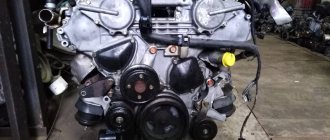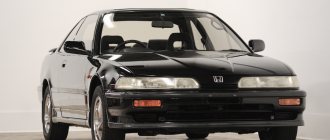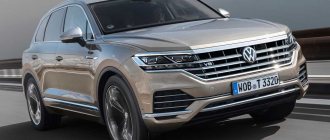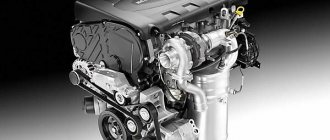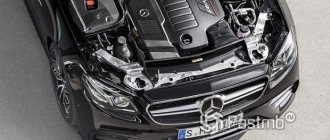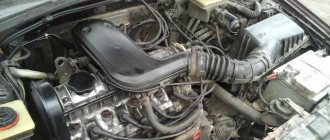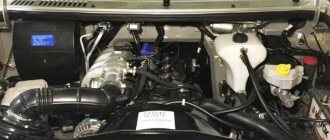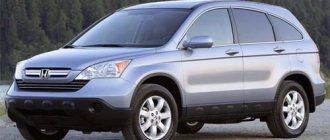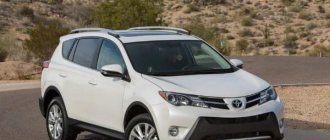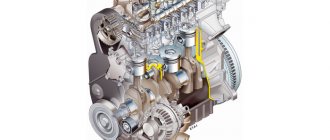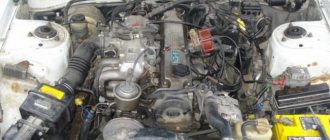Accord cars from the Japanese concern Honda are popular all over the world. This is a successful model that has been produced since 1976. Even today, Honda produces restyled Accords that have nothing in common with the 1976 models, including the powertrain.
The engines of that time with a cylinder volume of 1.6 and 1.8 liters had a power of 68-95 hp. A modern internal combustion engine with a cylinder capacity of 1.6 liters produces a power of 116 hp, but after 2001 Honda rarely produced subcompact Accords.
All Honda Accord engines
The table below shows the internal combustion engines used on Accord cars of all generations:
| Engine make | Volume, power | Generation Accord | Years of manufacture |
| K24W | 2.4 L (180 hp) | 9 | 2013-present time |
| J35Y | 3.5 L (281 hp) | 9 | 2013-2015 |
| R20A3 | 2.0 l (156 hp) | 8, 9 | 2008-present time |
| K24Z3 | 2.4 l (200 hp) | 8 | 2008-2013 |
| K20Z2 | 2.0 l (155 hp) | 7 | 2005-2008 |
| K24Z2 | 2.4 (180 hp) | 8 | 2008-2011 |
| K24A3 | 2.4 l (190 hp) | 7 | 2002-2008 |
| K24W4 | 2.4 (175 hp) | 9 | 2012-present time |
| LFA | 2.0 l (145 hp) | 9 | 2013-present time |
| L15 | 1.5 l (192 hp) | 10 | 2017 – our time |
| R20A | 2.0 l (156 hp) | 8 | 2011-2013 |
| K24A | 2.4 l (200 hp) | 7, 8 | 2002-2011 |
| K20A | 2.0 l (155 hp) | 7 | 2002-2008 |
| F23A | 2.3 l (158 hp) | 6 | 1997-2002 |
| H23A | 2.3 l (160 hp) | 6 | 1997-2002 |
| F18B | 1.8 l (140 hp) | 5, 6 | 1993-2002 |
| F20B | 2.0 l (148 hp) | 5, 6 | 1993-2002 |
| H22A | 2.2 l (220 hp) | 5, 6 | 1993-2002 |
| F22B | 2.2 l (145 hp) | 5 | 1993-1997 |
| F22A | 2.2 l (140 hp) | 4 | 1989-1994 |
| F18A | 1.8 l (105 hp) | 4 | 1989-1993 |
| F20A | 2 l (110 hp) | 4 | 1989-1993 |
| A18A | 1.8 l (110 hp) | 3 | 1985-1989 |
| B18A | 1.8 l (130 hp) | 3 | 1985-1990 |
| B20A | 2.0 l (160 hp) | 3 | 1985-1990 |
| EY | 1.6 l (94 hp) | 2 | 1983-1985 |
| ES | 1.8 l (110 hp) | 2 | 1983-1985 |
| E.P. | 1.6 l (90 hp) | 2 | 1981-1983 |
| E.K. | 1.8 l (97 hp) | 2 | 1981-1983 |
| E.F. | 1.6 (82 hp) | 1 | 1976-1997 |
| D16B6 | 1.6 l (116 hp) | 6 | 1998-2003 |
| F18B2 | 1.6 l (136 hp) | 6 | 1998-2003 |
| Rover 20T2N | 2.0 l (105 hp) | 6 | 1996-2003 |
| F20B6 | 2.0 l (147 hp) | 6 | 1998-2003 |
| F23Z5 | 2.3 l (154 hp) | 6 | 2001-2003 |
| H22A7 | 2.2 l (212 hp) | 6 | 1998-2003 |
| F22B5 | 2.2 l (150 hp) | 5 | 1994-1998 |
| F20B3 | 2.0 l (136 hp) | 5 | 1994-1997 |
| F18A3 | 1.9 l (115 hp) | 5 | 1996-1998 |
| F20Z1 | 2.0 l (131 hp) | 5 | 1996-1998 |
| F22Z2 | 2.2 l (150 hp) | 5 | 1996-1998 |
| F20Z2 | 2.0 l (115 hp) | 5 | 1993-1998 |
| H23A3 | 2.3 l (158 hp) | 5 | 1993-1996 |
| F20Z | 2.0 l (133 hp) | 4 | 1990-1996 |
| A20A1 | 2.0 l (102 hp) | 3 | 1985-1989 |
| A20A2 | 2.0 l (106 hp) | 3 | 1985-1989 |
| A20A3 | 2.0 l (115 hp) | 3 | 1985-1989 |
| A20A4 | 2.0 l (122 hp) | 3 | 1985-1989 |
| B20A8 | 2.0 l (133 hp) | 3 | 1985-1989 |
| B20A2 | 2.0 l (137 hp) | 3 | 1985-1989 |
| K24A8 | 2.4 l (166 hp) | 7 | 2002-2008 |
| J30A5 | 3.0 l (244 hp) | 7 | 2005-2008 |
| JNA1 | 3.0 l (255 hp) | 7 | 2005-2008 |
| K24A4 | 2.4 l (160 hp) | 7 | 2002-2005 |
| J30A4 | 3.0 l (240 hp) | 7 | 2002-2005 |
| F23A1 | 2.3 l (150 hp) | 6 | 2000-2002 |
| J30A1 | 3.0 l (200 hp) | 6 | 2000-2002 |
| F23A5 | 2.3 l (135 hp) | 6 | 2000-2002 |
| F22B2 | 2.2 l (132 hp) | 5 | 1993-1997 |
| F22B1 | 2.2 l (146 hp) | 5 | 1993-1997 |
| C27A4 | 2.7 l (172 hp) | 5 | 1995-1997 |
| F22A1 | 2.2 l (126 hp) | 4 | 1989-1994 |
| F22A6 | 2.2 l (142 hp) | 4 | 1991-1994 |
| F22A4 | 2.2 l (132 hp) | 4 | 1989-1994 |
Over the 40-year history of manufacturing Accord models, a lot of engines have been created. Within the same power plant, various modifications were created, which made it possible to improve or simply change the technical characteristics of the power plant. Naturally, there were both successful models and not so successful ones.
Characteristics
For the “seven” Honda Accord, two basic types of power units were developed:
- two-liter version K20A: with a displacement of 1998 cm³; power – 155/6000 hp/rpm; and torque – 192/4500 Nm/rpm;
- and a larger version labeled K24A: with a volume of 2354 cm³; power – 200/6800 hp/rpm; and torque – 237/4500 Nm/rpm.
For Europe, the Japanese concern Honda Motor has released only two modifications of its “K” series engines for the seventh generation Accord. The regular K20A did not receive any design changes, but began to be designated as – K20Z2. The K24A3 motor (based on the K24A) is a little “weakened” in its power.
In the American market, the Accord VII with 3.0-liter V-shaped sixes with 240 hp has long been in demand.
The Accord 7 also featured 2.0-liter turbodiesels with a power of 140 horsepower and a maximum torque of 340 Nm, intended for the Western European market.
Accord 7 for the European market, sedan (station wagon)
| Equipment | Engine | Body |
| 2.0 l, 155 hp, manual or automatic | K20Z2 | CL7; CM1 (station wagon) |
| 2.4 l, 190 hp, manual or automatic | K24A3 | CL9; CM2 (station wagon) |
Accord 7 for Japan, sedan
| Equipment | Engine | Body |
| 2.0 l, 152 hp, automatic (4WD) | K20A | ABA-CL8 |
| 2.0 l, 155 hp, automatic | K20A | DBA-CL7 |
| 2.0 l, 220 hp, manual | K20A | ABA-CL7 |
| 2.4 l, 200 hp, automatic | K24A | ABA-CL9 |
Accord 7 for Japan, station wagon
| Equipment | Engine | Body |
| 2.0 l, 155 hp, automatic | K20A | DBA-CM1 |
| 2.4 l, 160 hp, automatic | K24A | DBA-CM2 |
| 2.4 l, 160 hp, automatic (4WD) | K24A | ABA-CM3 |
| 2.4 l, 200 hp, automatic | K24A | ABA-CM2 |
US Accord 7 sedan
| Equipment | Engine | Body |
| 2.4 l, 166 hp, manual or automatic | K24A8 | CM5 |
| 3.0 l, 244 hp, manual or automatic | J30A5 | CM6 |
| 3.0 l, 255 hp, manual or automatic | JNA1 | CM6 |
Accord 7 for Southeast Asia, sedan, station wagon
| Equipment | Engine | Body |
| 2.0 l, 155 hp, automatic | K20A | CL7 |
Engine 2.0 K20A
Legendary B series motors
The B18A and B20A engines were installed on 3rd generation Honda Accord cars from 1985 to 1990.
The engines are very similar to each other structurally, the difference is in the volume of the cylinders. From the name it’s easy to guess that B18A is a 1.8-liter engine, B20A is a 2-liter engine. The most common was the B18A - a unit with an aluminum cylinder block and a crankshaft with a piston stroke of 89 mm. A valve head with 16 valves and two camshafts is installed on top; there is no VTEC system, although the latest versions have it. The power of this internal combustion engine is 130 hp. at 6000 rpm, torque – 164 Nm at 5000 rpm. However, the engine became legendary not because of its technical parameters, but because of the absence of design flaws and miscalculations. The entire series of B-series motors, including B18A and B20A, have a huge service life, are reliable and easy to maintain. Today, these engines are completely worn out, their service life has long been exhausted, but on expensive Russia there are still cars (and not only the Honda Accord, since the units were installed on other models) with these engines with a mileage of over 500 thousand km.
Series B engines are recognized as the best power plants of the concern in its entire history; they are characterized by low fuel consumption and have a huge operating range - from 3000 to 8000 rpm. With normal maintenance (rarely with abnormal maintenance), problems begin to arise after a mileage of over 150 thousand kilometers, and the first 100 thousand are very easy for the engine. There are even legends about these engines among motorists. According to them, Series B engines even ran on diesel fuel, and some drove to service stations with virtually no oil in the engine. At the same time, he roared and screamed, but still got to his destination. After simple repairs, the mechanics managed to revive even the most “dead” engines of the Honda B series, after which they successfully continued to work. All this allows us to draw a conclusion about the reliability of these engines, but today they are not produced, unfortunately.
K series engines
When the B engines no longer met modern environmental standards, the concern introduced new units - K20, K23, K24. These are 4-cylinder engines with timing chain drives. Unlike belt drives, chain drives on K engines have a huge service life - over 200 thousand km. The cylinder head is two-shaft (made according to the DOHC design), equipped with an i-VTEC phase distribution system, which was rarely used on B-series engines - only in late-production units. By the way, it was the use of the i-VTEC system that made it possible to significantly reduce the content of harmful substances in exhaust gases, which is why engines began to be installed on cars that were new at that time.
Also used on the Accord, the K20, K24 installations (with cylinder volumes of 2.0 l and 2.4 l) were performed without hydraulic compensators, which required adjusting the valve clearances every 40 thousand kilometers.
As for the performance characteristics of these engines, everything is excellent here. With a large volume and high power (155 hp), the internal combustion engines were distinguished by low fuel consumption - in the combined cycle, consumption was 7.4 liters per 100 km, and when driving on the highway it completely dropped to 6.4 liters. And although the K-series engines became popular and were installed in Honda Accords for a very long time (the K24W model is used in the new Accords in 2018), they were less reliable than their predecessors, the B-series engines.
In particular, owners face the following problems:
- Oil leaks. The specifications indicate that the possible lubricant consumption per 1000 km is 1 liter. The front crankshaft oil seal may also leak.
- Engine knocking is found specifically on the K20A, used on the 7th generation Accords from 2002 to 2008. The cause was wear of the exhaust camshaft; replacing it solved this problem.
- Vibrations caused by wear of one of the cushions. The cause may also be a stretched timing chain, but this is only relevant on old engines with a mileage of about 150 thousand kilometers.
- Overheating of the 4th cylinder - occurs on 2002 K20 engines. Since 2003, this deficiency has been eliminated.
The most modern K-series unit, the K24W, is in use today and is installed on the 9th generation Accord and the 5th generation CR-V models. This is a 2.4-liter power plant with a power of 180 hp. It consumes about 8 liters of AI-95 gasoline when driving on the highway, and more in the city. The engine itself, like all K engines, is a 4-cylinder in-line, equipped with two camshafts and an i-VTEC system. There are no serious design or technological flaws, but the problems described above are possible on running engines.
Options and prices
The car is not officially supplied to either Russia or Ukraine. Although it has already gone on sale in the USA and Japan. And Russian and Ukrainian car enthusiasts can buy such cars only on the secondary or “gray” market, and also bring them from abroad. You can navigate the sedan trim levels, of which there are as many as 5 in 2021, and the prices according to the offers for American showrooms.
The basic version is equipped with 8 airbags, an 8-inch diagonal multimedia system, a rear view camera, push-button engine start and dual-zone climate control. The list of equipment includes lane control and road sign reading systems, ESP, ABS and adaptive cruise control, 17” wheels and LED front running lights. An all-round camera is available as an option.
The differences between the Sport version are 19-inch alloy wheels and chrome trim elements. And also – seats with a sports profile and 12 adjustments, an audio system with 8 speakers and a spoiler. Top versions received full LED optics, heated seats for all seats and a head-up display. These same trim levels have support for Android Auto and Apple CarPlay.
Table 1. Car versions for the USA.
| Equipment name | Motors | checkpoint | Transmission | Cost, $ |
| LX | 1.5 l, 192 hp, gasoline | CVT | front-wheel drive | 24770 |
| Sport | Automatic transmission10 | 27230 | ||
| EX-L | CVT | 31090 | ||
| Hybrid | 2.0 l, 143 hp, hybrid | eCVT | 26370 | |
| Hybrid-EX | 30320 |
F-series
F-series engines were also widely used on Accords. In particular, specific modifications were installed:
- F23A, F18B, F20B – 6th generation.
- F18B, F20B, F22B – 5th generation.
- F22A, F18A, F20A – 4th generation.
They are 4-cylinder in-line engines running on gasoline. They can be equipped with two or one camshaft, have 16 valves, and a timing belt drive. These motors rotate counterclockwise.
Motor parameters:
- F18B: power 140 hp at 6100 rpm, there is a VTEC system, one camshaft.
- F20B: 148 hp at 6000 rpm, there is VTEC, single camshaft.
- F22B: 145 hp at 5200 rpm, VTEC is present, single camshaft.
- F22A is practically the same as F22B.
- F23A: 150 hp at 5800 rpm, with one camshaft.
Unlike the other series (H and B), these motors are considered more economical, inexpensive to manufacture and have high performance characteristics. Most internal combustion engines in this series are made with a single overhead camshaft, an integrated VTEC system. These engines have not become legendary like the B-series models, but are generally reliable. During the first 100-150 thousand km they behave perfectly and do not cause any problems to their owners. It is the simplicity of the design that ensures high reliability, since there are no fundamentally new or complex technologies inside these internal combustion engines. The only plus is the high torque at low speeds on the F20, F22, F23 engines. The 1.8-liter internal combustion engine does not even have this advantage, and the vaunted VTEC system here is activated late, so its effect is unnoticeable in city driving conditions.
There are also problems with F-engines; they do not have such a long service life as models of the B series. After a run of 150 thousand kilometers, oil consumption almost always increases, which can hardly be called a serious problem, however, against the background of B engines, oil consumption can be called a flaw .
Other problems in the series:
- The idle air valve is located on the far side of the intake manifold, making it difficult to access. This affects the price of its repair and replacement.
- Rubber hoses through which antifreeze is transported rot within 10 years, leak liquid and require replacement.
- The internal channels of the engine become clogged, the pressure in the system increases, and the gaskets are squeezed out. Fixing leaks on F-engines with mileage over 150 thousand is a common thing.
Despite the disadvantages, Honda Accords with F-series engines are extremely reliable, since the units are well studied and easy to repair due to their simple design.
Engine Honda Accord 2.4 liters
In-line, four-cylinder, 16-valve petrol engine of the Honda Accord with overhead camshafts and liquid cooling. The cylinders are numbered from the crankshaft pulley. The Accord 2.4 cylinder block is aluminum. To increase the rigidity of the cylinder block, the lower cover of the main bearings is made of one piece and is attached to the block with 24 bolts. The thrust half-rings are installed in the 4th support. Some modifications of this engine use balancing shafts to balance the second-order inertia force of the crankshaft.
For cooling, channels are made in the cylinder block through which coolant circulates. There are horizontal channels to lubricate the crankshaft, connecting rods, pistons and supply oil to the oil nozzles, and in the front of the block there is one vertical channel to supply oil to the cylinder head. On most engine models there is a phase shifter on the intake shaft. The intake manifold has variable geometry. The aluminum cylinder head does not have hydraulic lifters, so the valve clearance must be adjusted manually.
Series H
The series of engines described above were most often installed on Accords, but there were others (this is obvious from the table). The H23A and H22A engines were rarely used - inline 4-cylinder and 16-valve engines with a displacement of 2.3 and 2.2 liters, respectively. They also turned out to be quite reliable, but only subject to regular and high-quality maintenance. Over time, as on the F-series, oil leaks and antifreeze leaks occur; some owners complain about “brakes” caused by poor performance of knock sensors, temperature sensors, etc. If the maintenance is poor, the H-series engine does not last long - it is sensitive to the quality of oil, gasoline, and timely replacement of consumables. In this regard, it differs from B and even K-series engines.

